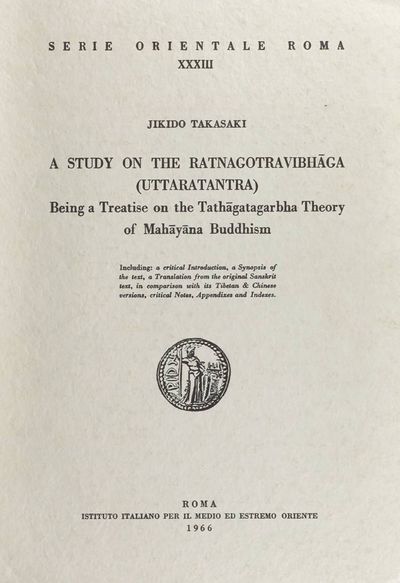A Study on the Ratnagotravibhāga (Uttaratantra)
No edit summary |
No edit summary |
||
| (11 intermediate revisions by the same user not shown) | |||
| Line 41: | Line 41: | ||
* {{i|Synopsis of the Text|63}} | * {{i|Synopsis of the Text|63}} | ||
* {{i|Translation and Notes|135}} | * {{i|Translation and Notes|135}} | ||
<center>Chapter I. — The Matrix of the Tathāgata</center> | <center>Chapter I. — The Matrix of the Tathāgata</center> | ||
*{{i|I. Introduction|141}} | *{{i|I. Introduction|141}} | ||
| Line 105: | Line 107: | ||
****{{i|3) Bodhisattva’s Compassion — The Parable of a Householder|246}} | ****{{i|3) Bodhisattva’s Compassion — The Parable of a Householder|246}} | ||
****{{i|4) Bodhisattva’s Perception of the Pure Mind|248}} | ****{{i|4) Bodhisattva’s Perception of the Pure Mind|248}} | ||
****{{i|5) | ****{{i|5) ' ''Saṃsāra'' ' in the Case of Bodhisattva|250}} | ||
****{{i|6) Bodhisattva in his 6th Stage|250}} | ****{{i|6) Bodhisattva in his 6th Stage|250}} | ||
****{{i|7) The Pure and Impure State of the Bodhisattva in comparison with the Ordinary Being and the Buddha|253}} | ****{{i|7) The Pure and Impure State of the Bodhisattva in comparison<br>with the Ordinary Being and the Buddha|253}} | ||
***{{i|(C) Unchangeability in the Perfectly Pure State|256}} | ***{{i|(C) Unchangeability in the Perfectly Pure State|256}} | ||
**{{i|(X) ''Asaṃbheda''|258}} | |||
***{{i|1) Synonyms of the Essence of the Tathāgata|259}} | |||
***{{i|2) The Point: Buddhahood is Nirvāṇa|261}} | |||
***{{i|3) The Parable of Painters|263}} | |||
***{{i|4) Similarity of the Buddhahood to the Sun|265}} | |||
*{{i|IX. The 9 Illustrations on the Germ covered with Defilements|268}} | |||
**{{i|1) The 9 Illustrations according to the Tathāgatagarbhasūtra|268}} | |||
**{{i|2) 9 Kinds of Defilements — the Impurities of the Mind|277}} | |||
**{{i|3) Concordance between the 9 Illustrations and 9 Kinds of Defilements|281}} | |||
**{{i|4) The threefold Nature of the Essence|283}} | |||
***{{i|a) ''Dharmakāya''|284}} | |||
***{{i|b) ''Tathatā''|287}} | |||
***{{i|c) ''Tathāgatagotra''|288}} | |||
*{{i|X. The Essential Characteristics of the Matrix of the Tathāgata|294}} | |||
**{{i|1) The Saying: ' All Living Beings are possessed of the Matrix of the<br>Tathāgata ' is the Highest Logical Truth|294}} | |||
**{{i|2) The 4 Kinds of Individuals to whom the Faith in this Essence is necessary|296}} | |||
**{{i|3) The True Conception of the Matrix of the Tathāgata as representing Non-substantiality|300}} | |||
*{{i|XI. The Purpose of Instruction|305}} | |||
<center>Chapter II. — The Enlightenment</center> | |||
*{{i|XII. General Characteristics of the Reality free from Pollutions|310}} | |||
*{{i|XIII. 8 Points on the Undefiled Reality|314}} | |||
**{{i|(I) ''Svabhāva'' & (II) ''Hetu''|314}} | |||
**{{i|(III) ''Phala''|315}} | |||
**{{i|(IV) ''Karman''|318}} | |||
**{{i|(V) ''Yoga''|322}} | |||
**{{i|(VI) ''Vṛtti''|324}} | |||
***{{i|a) The Body of the Absolute Essence|326}} | |||
***{{i|b) The Body of Enjoyment|328}} | |||
***{{i|c) The Apparitional Body|329}} | |||
**{{i|(VII) ''Nitya''|331}} | |||
**{{i|(VIII) ''Acintya''|334}} | |||
<center>Chapter III. — The Properties of the Buddha</center> | |||
*{{i|XIV. General Characteristics of the Buddha’s Properties|336}} | |||
*{{i|XV. The 64 Properties of the Buddha|338}} | |||
**{{i|(I) The 10 Powers|338}} | |||
**{{i|(II) The 4 Forms of Intrepidity|339}} | |||
**{{i|(III) The 18 Exclusive Properties|341}} | |||
**{{i|(IV) The 32 Marks of the Superman|343}} | |||
***{{i|(Commentary)|347}} | |||
<center>Chapter IV. — The Acts of the Buddha</center> | |||
*{{i|XVI. General Characteristics of the Acts of the Buddha|351}} | |||
*{{i|XVII. The 9 Illustrations on the Buddha's Acts|355}} | |||
**{{i|1) Buddha's Magnanimity|355}} | |||
**{{i|2) The 9 Illustrations taken from the ''Jñānâlokâlaṅkārasūtra''|356}} | |||
**{{i|3) Summary of the Illustrations given by the Commentator|374}} | |||
**{{i|4) Summary of Examples given in the Kārikās|375}} | |||
**{{i|5) Non-origination and Non-extinction of the Buddhahood|377}} | |||
**{{i|6) The Point of Dissimilarity|377}} | |||
<center>Chapter V. — The Merits of Faith</center> | |||
*{{i|XVIII. The Merits of Having Faith in the Doctrine of the Essence of Buddhahood|380}} | |||
**{{i|1) The Superiority of Faith to other Virtues in regard to their Merits|380}} | |||
**{{i|2) Authority, Motive, and Characteristics of this Text being the Correct<br>Doctrine|384}} | |||
**{{i|3) Means of preserving oneself within the Doctrine|386}} | |||
**{{i|4) Causes and Results of the Loss of the Doctrine|387}} | |||
**{{i|5) Conclusion|389}} | |||
| Line 123: | Line 195: | ||
** {{i|2. Index of Works, Authors & Schools|437}} | ** {{i|2. Index of Works, Authors & Schools|437}} | ||
|AddRelatedTab=No | |AddRelatedTab=No | ||
|PostStatus= | |PostStatus=Approved | ||
|StopPersonRedirects=No | |StopPersonRedirects=No | ||
|BookParentPage=Secondary Sources | |BookParentPage=Secondary Sources | ||
}} | }} | ||
Latest revision as of 17:56, 15 September 2020
Jikido Takasaki's seminal work on the Ratnagotravibhāga includes a critical introduction, a synopsis of the text, a translation from the original Sanskrit text in comparison with its Tibetan and Chinese versions, critical notes, appendixes, and indexes. The work is split into two parts. The first consists of a critical and detailed study on the structure of the text and the position of the Ratnagotravibhāga in Mahāyāna Buddhism, and the second consists of a translation of the Sanskrit text into English.
| Citation | Takasaki, Jikidō. A Study on the Ratnagotravibhāga (Uttaratantra): Being a Treatise on the Tathāgatagarbha Theory of Mahāyāna Buddhism. Serie Orientale Roma XXXIII. Rome: Istituto Italiano per il Medio ed Estremo Oriente (IsMEO), 1966. https://archive.org/details/bdrc-W1KG1582/page/n1/mode/2up. |
|---|---|


